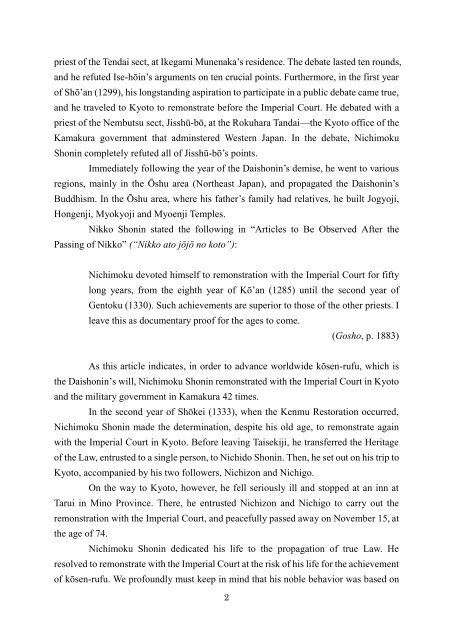Guidance from Sixty-eighth High Priest Nichinyo Shonin On the ...
Guidance from Sixty-eighth High Priest Nichinyo Shonin On the ...
Guidance from Sixty-eighth High Priest Nichinyo Shonin On the ...
Create successful ePaper yourself
Turn your PDF publications into a flip-book with our unique Google optimized e-Paper software.
priest of <strong>the</strong> Tendai sect, at Ikegami Munenaka’s residence. The debate lasted ten rounds,<br />
and he refuted Ise-hōin’s arguments on ten crucial points. Fur<strong>the</strong>rmore, in <strong>the</strong> first year<br />
of Shō’an (1299), his longstanding aspiration to participate in a public debate came true,<br />
and he traveled to Kyoto to remonstrate before <strong>the</strong> Imperial Court. He debated with a<br />
priest of <strong>the</strong> Nembutsu sect, Jisshū-bō, at <strong>the</strong> Rokuhara Tandai—<strong>the</strong> Kyoto office of <strong>the</strong><br />
Kamakura government that adminstered Western Japan. In <strong>the</strong> debate, Nichimoku<br />
<strong>Shonin</strong> completely refuted all of Jisshū-bō’s points.<br />
Immediately following <strong>the</strong> year of <strong>the</strong> Daishonin’s demise, he went to various<br />
regions, mainly in <strong>the</strong> Ōshu area (Nor<strong>the</strong>ast Japan), and propagated <strong>the</strong> Daishonin’s<br />
Buddhism. In <strong>the</strong> Ōshu area, where his fa<strong>the</strong>r’s family had relatives, he built Jogyoji,<br />
Hongenji, Myokyoji and Myoenji Temples.<br />
Nikko <strong>Shonin</strong> stated <strong>the</strong> following in “Articles to Be Observed After <strong>the</strong><br />
Passing of Nikko” (“Nikko ato jōjō no koto”):<br />
Nichimoku devoted himself to remonstration with <strong>the</strong> Imperial Court for fifty<br />
long years, <strong>from</strong> <strong>the</strong> <strong>eighth</strong> year of Kō’an (1285) until <strong>the</strong> second year of<br />
Gentoku (1330). Such achievements are superior to those of <strong>the</strong> o<strong>the</strong>r priests. I<br />
leave this as documentary proof for <strong>the</strong> ages to come.<br />
2<br />
(Gosho, p. 1883)<br />
As this article indicates, in order to advance worldwide kōsen-rufu, which is<br />
<strong>the</strong> Daishonin’s will, Nichimoku <strong>Shonin</strong> remonstrated with <strong>the</strong> Imperial Court in Kyoto<br />
and <strong>the</strong> military government in Kamakura 42 times.<br />
In <strong>the</strong> second year of Shōkei (1333), when <strong>the</strong> Kenmu Restoration occurred,<br />
Nichimoku <strong>Shonin</strong> made <strong>the</strong> determination, despite his old age, to remonstrate again<br />
with <strong>the</strong> Imperial Court in Kyoto. Before leaving Taisekiji, he transferred <strong>the</strong> Heritage<br />
of <strong>the</strong> Law, entrusted to a single person, to Nichido <strong>Shonin</strong>. Then, he set out on his trip to<br />
Kyoto, accompanied by his two followers, Nichizon and Nichigo.<br />
<strong>On</strong> <strong>the</strong> way to Kyoto, however, he fell seriously ill and stopped at an inn at<br />
Tarui in Mino Province. There, he entrusted Nichizon and Nichigo to carry out <strong>the</strong><br />
remonstration with <strong>the</strong> Imperial Court, and peacefully passed away on November 15, at<br />
<strong>the</strong> age of 74.<br />
Nichimoku <strong>Shonin</strong> dedicated his life to <strong>the</strong> propagation of true Law. He<br />
resolved to remonstrate with <strong>the</strong> Imperial Court at <strong>the</strong> risk of his life for <strong>the</strong> achievement<br />
of kōsen-rufu. We profoundly must keep in mind that his noble behavior was based on



